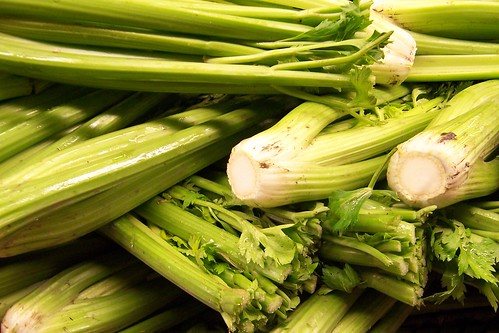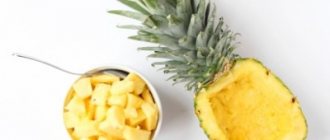Celery during breastfeeding tones the mother's body and helps the harmonious development of the baby. The spice has a beneficial effect on the growth process of the skeleton and muscles. All varieties and parts of the plant are used in cooking. It is added to salads, main courses, and drinks.
Can nursing mothers eat celery? The seasoning is allowed to be consumed, but with caution. Exceeding the permissible dosage will lead to excessive gas formation and allergic symptoms in the baby. Nursing mothers can eat celery no earlier than the third month of lactation, when the baby’s body learns to digest complex food components.
Composition, varieties, calorie content
Celery for a nursing mother is beneficial due to the content of vitamins A, group B, C, E, PP, H, K, macroelements - calcium, potassium, magnesium, silicon, sodium, sulfur, phosphorus, microelements - aluminum, boron, vanadium, iron, iodine, starch, saturated and polyunsaturated fatty acids.
There are three types of vegetables - root, petiole, leaf. The first is grown for its root crops. The second is because of the fleshy petioles. The third is green foliage, renewed from spring to autumn.
Nutritional value of the crop (in 100 g):
| Calorie content | 13 kcal |
| Squirrels | 0.9 g |
| Fats | 0.1 g |
| Carbohydrates | 2.1 g |
| Alimentary fiber | 1.8 g |
| Water | 94 g |
Beneficial features
Celery is recommended for nursing mothers due to its positive health effects:
- vitamin E increases the protective barrier, prevents the formation of hypoxia;
- potassium normalizes the balance of water and alkalis;
- calcium is important for intracellular reactions and bone strength;
- carotene inhibits the activity of free radicals;
- phosphorus prevents bone pathologies from developing;
- vitamin PP promotes the formation of enzymes and reactions with oxygen;
- flavonoids inhibit the activity of pathogenic microbes.
Acids:
- ascorbic acid is considered an antioxidant, it prevents wear and tear of the body, supports bone function;
- oxalic acid regulates muscle contractions;
- glutamine has a beneficial effect on the nervous system.
Harm and contraindications for breastfeeding
The roots, leaves and stems of celery are not always beneficial for a nursing mother. The use of different parts of the spicy plant is contraindicated in the following cases.
Harm during lactation:
- contains a large volume of essential oils in high concentration, therefore prohibited for people with allergies;
- the plant increases the acidity of gastric juice and is not recommended for gastritis;
- the root of a fresh vegetable activates the movement of stones, for this reason it is dangerous for kidney pathologies;
- celery during breastfeeding is contraindicated in case of varicose veins and thrombophlebitis, since it increases blood viscosity, causing the formation of clots;
- the use of spices is contraindicated in case of epilepsy, since essential oils provoke seizures;
- celery can be dangerous for babies because it changes the taste of mother's milk. As a result, the baby will refuse natural feeding;
- Consumption of the vegetable is not recommended for uterine bleeding due to its ability to increase blood pressure.

The benefits and harms of celery for women and men
Our ancestors sincerely believed that celery brought happiness, while the ancient inhabitants of the Mediterranean considered it a symbol of sadness and death. The song of praise to this miracle plant is heard everywhere today. But despite the delicious taste, in some cases it may be contraindicated.
Is it true that celery is the most important of all vegetables?
The vegetable crop of the Umbelliferae family has equally edible aromatic leaves and crisp, juicy stems, and the spicy root vegetable is a storehouse of microelements, antioxidants and organic acids.
Scientists say that celery root, due to its unique composition, may well compete with ginseng root
Avicenna, who called celery “Greek parsley,” considered this vegetable unique in its properties, capable of curing any disease of the gastrointestinal tract and healing dropsy.
In Rome and Ancient Greece, celery leaves were minted on coins, and for the Egyptians it was a ritual plant; wreaths were woven from its flowers, and the greens were used in folk medicine. Back in the 5th century, the ancient Slavs borrowed a herbaceous crop from the Greeks and called it “seline” (lat.
selīnum - cumin-leaved gircha, a relative of celery), but it was officially recognized much later - only in the middle of the 18th century, during the reign of Catherine II.
The biennial plant is light-loving and requires watering; it is recommended to grow it through seedlings and plant it in well-warmed beds with neutral soil acidity
The terrestrial part of the plant is the first remedy for vitamin deficiency, increases the overall tone of the body and regulates the immune system due to the rich content of vitamin C, and magnesium and vitamin B1 help resist depression, fatigue and muscle weakness. In cooking, medicine and cosmetology, celery is used fresh and dried; seeds rich in essential oils are also used. The many faces of celery are truly versatile:
- Celery removes uric acid and has a diuretic effect (used for urethritis and cystitis).
- It has a positive effect on the endocrine system and is effective for diabetes. This is especially true for fresh plant stems; they have a low glycemic index and evenly release useful energy to the body without increasing blood sugar levels.
- An infusion made from celery root vegetables has a positive effect on hormonal levels.
- Potassium, which is found in the largest amount in the dried root vegetable, and omega-3 fatty acids, which celery greens are rich in, help support the cardiovascular system.
- Essential oils concentrated in celery seeds have an analgesic effect. Celery oil is perfect for massage and inhalation.
- The wound-healing property allows the petioles and roots to be used for preparing ointments, lotions and compresses; Any part of the plant has an equally effective regenerating effect on cells.
- Thanks to sodium and chlorine in the fiber, celery helps regulate the body's water-salt metabolism, so decoctions and preparations based on it are used for joint pain and gout.
- Reduces the likelihood of developing cancer by removing carcinogens and toxic substances from the body.
- Phosphorus contained in greens is involved in protein-carbohydrate metabolism and is necessary for teeth and bones.
- A large amount of fiber helps get rid of constipation and normalize liver function. Celery root is especially conducive to this; it is distinguished by high levels of vitamin B2 and B6.
- A diet based on celery helps to quickly get rid of excess weight and cellulite. Mustard oils (terpenes), which are part of the plant's fiber, work in the fight against obesity.
Fresh celery normalizes metabolism and regulates the amount of cholesterol in the blood
The chopped, fleshy celery root vegetable is added to salads and stews; when stewed, it goes well with fish and meat; the leaves of this miracle seasoning are added to casseroles, omelettes and soups, and the tender stalks are irreplaceable in smoothies and snacks.
Juices, cocktails and aromatic sauces for side dishes are also made from celery.
I remember one relative told me how to cure cracked heels. To do this, combine the tops and leaves of the plant, crushed in a mortar, with grated raw potatoes and apply to the wounds overnight. But I have not yet personally verified the effectiveness of the method.
What are the benefits of celery for women?
celery is valued in cosmetology: decoctions help strengthen hair, the juice of the plant has whitening properties, and masks and lotions are prepared from the stems and roots.
and celery's natural antioxidants help fight premature skin aging
The magnesium contained in the plant alleviates premenstrual syndrome and helps avoid unpleasant pain during menopause. To relieve swelling in the legs, doctors recommend drinking a glass of multi-fruit cocktail at night, which contains at least 50% celery juice.
why do men eat celery
celery is a powerful aphrodisiac; all parts of the plant contain large amounts of the hormone androsterone, so the vegetable increases potency. For sexual impotence, it is recommended to drink juice made from celery root vegetables. The diuretic properties of the plant help fight the preconditions for the occurrence of diseases of the male genitourinary system.
It is believed that celery can defeat prostatitis and restore libido
for whom celery is contraindicated
Culinary dishes and juices that contain celery are not recommended for pregnant women, as this plant increases the tone of the uterus.
It is believed that celery can cause flatulence in the intestines, so nursing mothers should also avoid this vegetable.
Its juice can penetrate into the milk and increase gas formation in babies, which often causes anxiety for infants.
Excessive consumption of celery juice and various types of this vegetable in culinary dishes can pose a risk of miscarriage.
Celery is contraindicated for some serious diseases:
- Cholelithiasis.
- Thrombophlebitis (inflammation of the veins, accompanied by their blockage with blood clots).
- Epilepsy.
- Nephrolithiasis (formation of kidney stones).
- Pancreatitis, gastritis and peptic ulcer.
- Arterial hypertension (chronic hypertension).
- Thyroid diseases.
- Allergies and individual intolerance.
Celery root in any form is considered the most useful: its nutritional value and vitamin composition are several times higher than those of other parts of the plant. The chemical composition of leaf and petiole celery is almost identical.
How to select and store
The leaf variety of the plant is used to prepare sauces; the stem and roots are used for main courses; any variety is suitable for soup. When purchasing celery for nursing mothers, carefully inspect the foliage. There should be no stains, damage, or signs of disease.
The color of the leaves of a quality product is bright green and uniform. The presence of inclusions indicates the use of chemicals. Old specimens have a dark color; they can be eaten after peeling the stems.
Torn leaves will indicate that the seller is trying to sell stale goods by eliminating damaged parts. The smell of a quality product is aromatic and rich, and its absence indicates chemicals. You should not buy spices with damage, they could be caused by rodents.
When choosing celery root when breastfeeding, take into account that large fruits have greater rigidity and less pronounced taste characteristics. There should also be no rot or soft spots on them. Carefully inspect the top, because it is from here that the root crop begins to deteriorate.
Leaf celery is stored on the bottom shelf of the refrigerator, wrapped in cling film or placed in an airtight container. To store root vegetables, use boxes with sand, which are placed in a cool place, with a temperature no higher than 20 C. It is possible to freeze any parts of the plant; with this method, the shelf life increases to three months.
To prepare an aromatic seasoning for the winter, celery greens are dried by spreading them on paper in a well-ventilated place. From time to time the leaves are turned over. The finished product is stored in airtight jars.
It will take at least a week to dry the root vegetables. After washing, the vegetable is cut into thin pieces and laid out on a paper towel in one layer. Drying takes place in a ventilated area in direct sunlight. The finished product is ground in a blender and placed in jars.
Rules for use during lactation
Introduction to the diet for breastfeeding
During the first month of breastfeeding, celery should not be added to the list of foods consumed. The baby needs time to adapt to unusual environmental conditions. His stomach and intestines learn to digest food. Therefore, do not eat foods that cause colic and allergic symptoms.
In the second or third month, you can try a small piece of the vegetable. Then the baby’s health is monitored for two days. If there are no allergies, colic, anxiety, celery during lactation is consumed in reasonable quantities, boiled or stewed. In case of rashes or other manifestations, the vegetable is allowed after 30 days.
At 3-6 months, fresh greens are included in the menu. For the first sample, take a little leaf variety. If the child has no rash, indigestion, or sleep problems, the portion is increased.
Daily norm
Add no more than 5 g of celery to food daily. The weekly norm is 15 g. It is better not to eat the seasoning more than once every 7 days.
Effect on lactation
While breastfeeding, a woman is allowed to eat celery no earlier than the baby is 3 months old.
There is no scientific evidence of the effect of celery on lactation. Some nursing mothers note an increase in milk volume when the product is included in the diet, while others, on the contrary, believe that celery reduces milk production. Considering that the vegetable has a mild diuretic effect on the body, this can have a positive effect on the secretion of glands, including mammary glands, but this indicator is individual. Experts are of the opinion that celery does not have a significant effect on lactation, but drinks with plant juice can stimulate milk production by increasing the proportion of fluid in the body.
Feedback from nursing mothers and expert opinion
I ate. everything was fine. but here, of course, it depends on the child.
£Mercantile Parasite¥
https://www.baby.ru/community/view/3335924/forum/post/221705535/
A very useful thing, but even if you crack it, it doesn’t taste like anything :)))))
Irina
https://www.baby.ru/blogs/post/137956733–64705558/
not advisable, because This is a spicy-fragrant plant and the child may refuse to breastfeed, and the child’s stomach may rebel. but you can’t lose weight during guarding. the milk will be less fat and the baby will lack vitamins and minerals.
Hope
I squeeze the juice out of celery and drink it along with apple juice, it’s disgusting to eat. All is good)
Plato's mom
https://deti.mail.ru/forum/nashi_deti/kormim_grudju/selderej/
Firstly, celery as a spice is absolutely compatible with breastfeeding - add it to any dishes without fear, your milk will not go anywhere. Secondly, celery boiled, stewed, fried, etc. The form is similarly suitable for a nursing mother. This plant is low in calories (100 grams contains only about 30 kcal). If you are concerned about the taste of milk or an allergy in your child, proceed as usual - eat a little first, wait and check the child's reaction, then include celery in your menu. In any case, if your body “demands” exactly it, then this particular root vegetable contains substances that you really need right now. Thirdly, raw juices (in stores and cafes they like to make carrot-celery juice, for example) and raw celery - there may already be nuances here, because It is in this form that this root vegetable is used to treat or prevent any “sores” (for example, as a laxative, diuretic, for nervous disorders, etc.)
Razakhatskaya Natalya International Breastfeeding Consultant (IBCLC), sling consultant, coach
https://am-am.info/faq/menyu-kormyashhej-mamy/selderej-pri-gv/
Rules for eating celery while breastfeeding
Negative consequences for mother and baby from eating celery can be avoided by responsibly approaching the formation of a “celery menu”. Follow these guidelines:
- Do not introduce celery in the first month of your baby's life. The optimal period is no earlier than 3 months of age.
- Start introducing celery root into your diet as part of soups. If there is no negative reaction, try the stems next, then the boiled or stewed leaves.
- Try a new product in the morning, after the baby is put to the breast.
- The amount of product in the first days of tasting should be minimal, gradually increasing it to 100 g per day (15 g for dried celery).
- If signs of an allergy or eating disorder appear in the baby, the product should be excluded from the diet.
- Cocktails, juice and dishes made from fresh celery are allowed to be tried if the child has no negative reactions to the thermally processed product, but not earlier than he is 4-6 months old.
- The norm of pure celery juice for a nursing mother is no more than 50 ml per day.
Folk recipes
To treat allergies, chop 2 tablespoons of celery root and add cold water. Leave for a couple of hours. Drink 1/3 cup three times a day before meals.
Purulent wounds and boils are treated with the prepared mixture. Half a glass of crushed leaves is poured with vinegar. Add a pinch of salt. Apply to sore spots. To get rid of insomnia and neuroses, take 2 teaspoons of fresh celery juice daily before meals.
A vegetable remedy will help with gastritis. 40 g of crushed root are infused in a liter of boiling water for 8 hours. Take two tablespoons before meals three times a day.
For arthrosis and joint problems, one kilogram of celery along with leaves and roots is passed through a meat grinder. Add three squeezed lemons. Infuse for a week in a dark place. Squeeze, add 300 g of honey. The product is stored in the refrigerator, take a tablespoon before each meal.
For bursitis, drink tea from the vegetable. A pinch of plant seeds is poured into a glass of boiling water. Leave for an hour and a half and filter. The tea is consumed a couple of times a day for two weeks in a row.
Celery during breastfeeding helps a woman quickly restore her prenatal forms and relieves fatigue and depression. The baby's body is saturated with nutrients. But there is no need to overuse the spicy plant, otherwise allergies and digestive disorders will not be avoided. Celery is included in the diet of nursing mothers from the third month of lactation, first eaten stewed and boiled. If there is no negative reaction, add fresh vegetables to the dishes.
If you find an error, please select a piece of text and press Ctrl+Enter.
Celery during breastfeeding
Celery is a unique plant, the beneficial qualities of which cannot be doubted.
It has found its wide application not only in cooking, but also in medicine, thanks to its inherent healing properties.
The composition of this plant is rich in minerals, vitamins and beneficial microelements that have a beneficial effect on the human body. Is celery useful during lactation? Let's figure it out.
Benefits of celery
Eating celery while breastfeeding has great benefits:
- makes the diet of a nursing woman much more varied. Thus, celery root goes well with various meat and fish dishes, vegetable vitamin salads;
- During lactation, celery enriches milk with riboflavin, nicotinic acid, thiamine, amino acids, vitamins K, A, E and essential oils;
- due to its tonic properties, this plant strengthens the immune system and has a beneficial effect on vision;
- improves mother’s digestion, promoting better absorption of food and its faster processing;
- Celery juice helps a nursing mother lose extra pounds gained during pregnancy.
Harm of celery
During lactation, celery is not recommended to be consumed in the first months of the baby’s life. This is explained by the fact that, along with its beneficial properties, this plant provokes gas formation.
Therefore, if a nursing mother introduces celery into her diet, it is likely that little children will begin to feel severe discomfort in their tummy, which can cause them to be capricious and restless.
In addition, celery contains allergens. These substances are insignificant for an adult, but for a small child they are quite enough to cause a negative reaction. Burning sensation, skin redness, itching, rashes - these are the consequences of consuming celery during lactation.
The fiber contained in celery is difficult to process by a child’s still immature stomach, which in turn can cause dysbiosis and other gastrointestinal problems.
Should I eat celery during lactation?
Celery, of course, should be present in the diet of a nursing mother. However, it is best to wait until the baby is 6 months old and introduce this product, like all others, gradually, carefully observing the baby’s reaction.
One of the most pleasant aspects of pregnancy is the removal of food restrictions, because you can eat whatever you want and in unlimited quantities with the only requirement - the maximum usefulness of the dishes.
After childbirth, the situation changes dramatically, since now everything that a nursing mother eats and then passes on to the baby through breast milk must be processed on its own.
Considering that the digestive system of an infant is imperfect, not everything can be eaten by the mother; even healthy vegetables have to be divided into those that are and are not allowed.
Why can't you eat some vegetables?
Each vegetable contains many vitamins and microelements, which, of course, are necessary for the baby’s body, but some of them, for example, due to their rich color, can cause an allergic reaction. Suppose beets contain iron, folic acid and even vitamin C, but due to their bright color, this particular vegetable can cause a rash on the baby’s face or body.
For example, cabbage is also a very healthy vegetable that contains ascorbic acid and vitamin B, but when it enters the baby’s body, even through breast milk and, of course, no longer in its pure form, cabbage causes abundant fermentation, which manifests itself in colic and bloating of the baby's tummy.
It is worth remembering garlic, as well as other spicy vegetables, which, despite their incredible health benefits, still affect breast milk and can change its taste, which will lead to unnecessary difficulties for both mother and baby. It is undesirable, especially in the first days after the birth of a child, to eat canned vegetables, which do not contain many useful substances and are characterized by an abundance of preservatives and vinegar essence.
What vegetables can mom eat?
As a rule, all doctors recommend that nursing mothers eat only those vegetables that grow in their place of residence and to which they have become accustomed since childhood.
This is due to the fact that in the body of each person certain types of enzymes are formed, which help process certain products.
Subsequently, the body’s ability to assimilate certain groups of foods is transmitted at the genetic level, and accordingly, a newborn child also possesses them.
If a mother has eaten potatoes, cucumbers, cabbage, carrots, tomatoes and onions throughout her life, she may not change her diet during breastfeeding, since the baby is able to digest the above vegetables.
But it is better to abstain from celery or fennel, even despite their usefulness, since these vegetables were not available to everyone 10-15 years ago, and accordingly, the mother’s body most likely will not have the necessary enzymes.
It should be noted that the diet of a nursing mother is subject to strict control precisely during the first weeks of the baby’s life; with each subsequent month, the baby’s body gets stronger and improves, and accordingly, it becomes possible to diversify the daily diet of both mother and baby, within reasonable limits, of course.
Source: https://ladym.ru/publ/pitanie_dlja_detej/selderej_pri_grudnom_vskarmlivanii/10-1-0-4713









